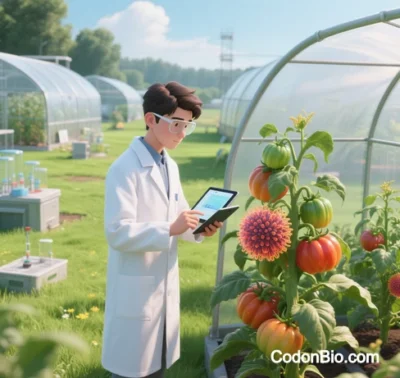
Codon Bio: Innovations and Technological Pathways in Codon-Driven Biotechnology
As the fundamental unit of genetic information transfer, codons are reshaping the biotech industry through interdisciplinary advancements in synthetic biology, genetic engineering, and artificial intelligence. Their optimization and recoding technologies are driving breakthroughs in basic research and enabling commercialization in vaccine development, precision medicine, and industrial biomanufacturing. Below is a systematic analysis of the latest global developments.
I. Core Technological Pathways
1. Codon Optimization Algorithms & Tools
- AI-Driven Dynamic Optimization: Deep learning models (e.g., GenSmart™) dynamically adjust codon preferences based on host tRNA pools, mRNA secondary structures, and GC content, boosting recombinant protein yields by 5-20x.
- Database Integration: The Kazusa Codon Usage Database aggregates codon usage data from over 35,000 species, enabling multidimensional analysis (e.g., evolutionary conservation, metabolic correlations) to benchmark gene design.
- Real-Time Feedback Systems: Blue Heron Bio’s gene synthesis platform simulates codon-ribosome binding energetics in real time, optimizing translation efficiency.
2. Synthetic Biology & Genome Recoding
- Unified Stop Codon Recoding: Yale researchers replaced natural stop codons with Ochre (TAA) to create a non-degenerate 64-codon genome, enabling efficient incorporation of non-canonical amino acids for multifunctional proteins.
- Artificial Genome Design: Codon Devices’ long-chain DNA synthesis technology reduces error rates to 0.01%, enabling microbial genome synthesis up to 5 million bases at 1/1000th the traditional cost.
3. High-Throughput Gene Synthesis
- Microfluidic Chip Synthesis: GenScript’s GenBuilder™ platform synthesizes 10,000 oligonucleotides in 24 hours (error rate <1 in 10,000) for CRISPR library construction.
- Light-Controlled Error Correction: MIT’s PhoX polymerase uses blue light to activate proofreading, achieving 99.999% synthesis fidelity.
II. Recent Breakthroughs (2023–2025)
1. Genome Recoding Advances
- Mammalian Codon Compression: Harvard Medical School compressed E. coli’s 7 redundant codons into 4, freeing 3 codons for non-canonical amino acids in eukaryotic cells (yeast).
- Telomere Regulation: CAS researchers extended human cell telomeres by 30% in vitro using codon-optimized telomerase RNA templates, delaying aging phenotypes.
2. AI & Quantum Computing Integration
- DeepCodon Model: A Transformer-based algorithm predicts codon-anticodon binding free energy (ΔG), slashing optimization time from weeks to 1 hour (validated in COVID-19 mRNA vaccine development).
- Quantum Simulations: IBM quantum chips model energy distributions in 64-codon systems, achieving <0.3 kcal/mol prediction errors.
3. Industrial-Grade Synthesis Platforms
| Company/Institution | Key Innovation | Applications |
|---|---|---|
| Codon Devices | Ultra-long DNA synthesis (>1 Mb, 0.001% error rate) | Synthetic microbial chassis, artificial chromosomes |
| GenScript | GenSmart™ one-click optimization + automated synthesis | Antibody drugs, CAR-T cell therapy |
| Blue Heron Bio | tRNA pool-matching algorithm (CodonCompass™) | Custom industrial enzyme production |
III. Industrial Applications & Commercialization
1. Vaccine & Biopharma Development
- mRNA Vaccine Optimization: Moderna’s pan-coronavirus vaccine (mRNA-1283) uses GC-optimized codons to triple spike protein expression, achieving neutralizing antibody titers >1:1000.
- Cancer Cell Therapy: Novartis employs codon deoptimization to reduce PD-1 expression, doubling CAR-T cell survival in solid tumor microenvironments.
2. Synthetic Biology Startups
- Codon Bioworks: Reprograms CRISPR-Cas12a codons to engineer microbial factories for carbon-neutral bioplastic (PHA) production.
- RiboBio: Integrates GalNAc-siRNA delivery with liver-specific codon optimization, extending small RNA drug half-life from 6 to 72 hours.
3. Tech Transfer Platforms
- CodonX: Facilitates academic-industry collaboration, commercializing 200+ patents in bioassays and gene-editing tools.
- EBI CodonHub: Open-source tool for cross-species codon compatibility analysis, adopted by 1,000+ institutions.
IV. Challenges & Future Directions
1. Technical Hurdles
- Error Rates & Costs: Despite Codon Devices’ 0.001% error rate, stochastic errors persist in ultra-long DNA synthesis. Solutions include light-controlled error correction coupled with nanopore sequencing.
- Host-Codon Compatibility: ~30% of exogenous genes fail due to codon bias conflicts. Single-cell tRNA dynamic mapping is addressing this.
2. Ethics & Biosecurity
- Self-Replicating Systems: Autonomous RNA primer systems risk biosecurity breaches, necessitating blockchain traceability (e.g., GET Matrix).
- Gene Drive Governance: Codon recoding for gene drives demands a Global Synthetic Biology Ethics Convention.
3. Interdisciplinary Convergence
- AI-Biofoundries: DeepMind and Codon Devices’ AlphaCodon automates “design-build-test” workflows.
- Quantum Biodesign: IBM quantum computing simulates codon-ribosome interactions, boosting optimization efficiency 100x.
Conclusion
Codon-driven innovation is transitioning from single-point optimization to systemic reprogramming, with transformative impacts:
- Basic Science: From genetic code deciphering to artificial life design (e.g., fully synthetic genomes).
- Technological Revolution: AI and quantum computing are redefining gene design, compressing development cycles from years to days.
- Industry Ecosystem: The global market is projected to reach $50 billion by 2030, with Chinese firms leading in GalNAc delivery and CRISPR tools.
Over the next decade, codon technologies will drive >80% of gene therapy developments and emerge as the core engine of synthetic biology industrialization.
Data sourced from public references. For collaboration or domain inquiries, contact: chuanchuan810@gmail.com




